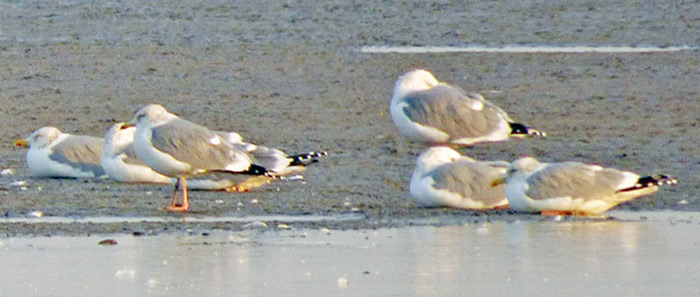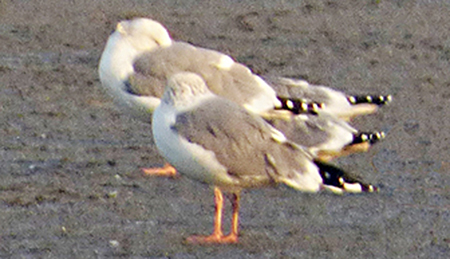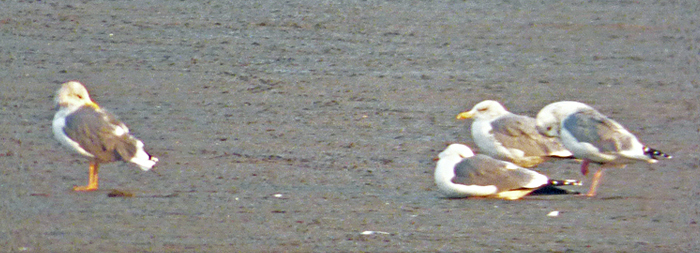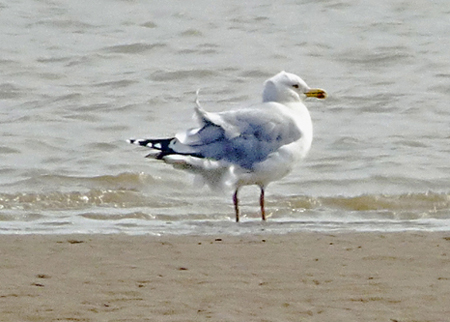'Large White-headed Gulls' |
Several large assemblies of LWHGs were encountered during a trip to eastern China during January 2015. The principal sites were on the coast at Yancheng (Jiangsu province) and on the Minjiang Estuary near Changle (Fujian province).
Species known to occur in winter along the Pacific coast of China include Mongolian Gull Larus mongolicus, Vega Gull L. vegae and Taimyr Gull L. taimyrensis (traditionally treated as an easterly component of Heuglin’s Gull L heuglini or even a hybrid population between heuglini and vegae but now regarded as warranting specific recognition). However, clear identification features for distinguishing between these forms are still not firmly established, particularly for mongolicus and vegae. Observations based upon extralimital (wintering) gulls clearly involve a degree of speculation as to their true identity. Individual variation among all LWHGs compounds the problems.
Notionally there are more-objective criteria, such as that mongolicus is white-headed in winter whereas vegae displays copious head-streaking, frequently extending to encompass the breast and producing a cowl of gingery-brown streaks. Such features are potentially useful but the indications now are that there are exceptions to this, while individual gulls of western LWHG taxa can become white-headed quite early in the winter (e.g. by late December/early January in argentatus) and this no doubt applies to eastern taxa as well.
Subtle differences in wing-pattern (number of primaries displaying black and extent of pale ‘veins’ on inner webs) can be difficult to ascertain in the field while individual variation means that application for an individual gull is problematic. However, ‘on average’ characters assessed from a large assembly of gulls should be informative, while recognising that such assemblies are likely to include more than one taxon.
The following photos show the general appearance and plumage of the gulls encountered, though range and light conditions precluded definitive photos. Also, shade of mantle varied according to light conditions and position of individual gulls with respect to prevailing light direction. However, it was concluded that the majority of individuals were most likely Mongolian Gulls, with a few Taimyr Gulls included. Flight photos taken by Paul Gale show that at least some individuals had a primary pattern corresponding with mongolicus (extensive black, extending to p4).

Plate 1. LWHGs at Yancheng, January 8th 2015. Presumed Mongolian Gulls.
In plate 1, with this group of gulls all facing in the same direction, note the reasonably consistent shade of mantle (Kodak Grey Scale circa 6, i.e. recalling hue of michahellis). On individuals with freshest-looking wing-point, there are four primary tips (apical spots) clear of the tertials with a fifth merging with or lying just under the white tertial crescent. Some variation in size and structure may suggest more than one species but individual and sexual variation in these respects is considerable within all LWHG taxa. All birds checked displayed evident streaking on nape (creating well-defined nuchal collar on gull at extreme left). Strong lighting from the right led to 'burn out' of detail and made assessing (and photographing) the true density and full extent of head streaking difficult. When heads were turned away from the light, the prominence of streaks was revealed as greater than many images might suggest - see 'zoomed' image in plate 2 below. However, there was no indication of heavy streaking or blotching extending to the breast, as in many winter Vega Gulls. With an assembly involving such numbers then, if vegae were present in significant numbers, at least some with heavy breast streaking would be anticipated. Presumption, therefore, was that these were at least predominantly Mongolian Gulls. A proviso arose subsequently from a gull later observed at Changle (see below), which was more confidently assigned to Mongolian Gull yet appeared to differ in character from most of the gulls at Yancheng.

Plate 2. 'Zoomed' image of rear of head. When turned away from dominant direction of light, dense streaking was more prominently revealed. However, such heavy streaking did not appear to extend to foreneck or breast.

Plate 3. LWHGs at Yancheng, January 8th 2015. Presumed Taimyr Gull at extreme left; two Presumed Mongolian Gulls on right; identity of gull third from right debatable.
In plate 3. the single gull on the left has well-streaked head and hind-neck, relatively dark mantle (Kodak Grey Scale c. 7.5, i.e. approaching graellsii) and yellow legs. Also, the primary moult has apparently not yet completed by early January. Notionally, these features would be associated with Taimyr Gull taimyrensis (though exclusion of heuglini would be based on geographical basis only). In the group of three gulls on the right, the two standing individuals appear to have a mantle hue a shade paler than the sitting gull, in which the hue matches that of the single, isolated gull to the extreme left in the image. Unhelpfully, the sitting gull appears quite white-headed while the isolated gull on the left has plentiful streaking. The individual on the extreme right has pink legs. The rather low fore-crown. the forward position of the eye and the rather long bill of the gull in the centre of the group of three were typical of many of the gulls present at Yancheng, while the iris (when visible) appeared pale. These characters are not especially associated with mongolicus (where, for example, many appear rather round-headed and dark-eyed, at least in breeding season - see comments and photos in the literature e.g. Olsen & Larsson).

Plate 4. LWHG, Changle, January 9th 2015. Presumed Mongolian Gull.
This LWHG at the Minjiang estuary near Changle (plate 4) has blue-grey upperparts and no obvious head-streaking, suggesting Mongolian Gull. It appears rather more-neatly proportioned than the predominant type at Yancheng. The head appears proportionately larger and more rounded and the bill deeper. The mantle appears a touch more 'blue-grey', less slaty. There is arguably a subtle difference in the spacing of the white apical spots on the primaries. Yet again, light conditions and posture warrant caution in assessing many of these features but, in combination, they produce a rather different impression from that predominating at Yancheng. This may be an individual more advanced into breeding plumage (yet that would not explain any genuine difference in wing-tip pattern). Whether seasonally related or a product of light conditions, this individual is more reminiscent of definite Mongolian Gulls photographed on the breeding grounds (see e.g. Olsen & Larsson).